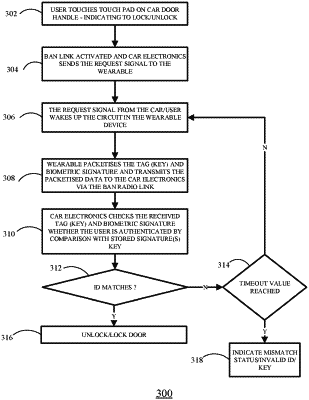| CPC G07C 9/00563 (2013.01) [G07C 9/00309 (2013.01); G07C 2009/00317 (2013.01)] | 10 Claims |

|
1. A portable device for an access control system, the portable device comprising:
a biometric sensor configured to detect biometric signals;
a memory configured to store a digital identifier;
a body area network, BAN, transceiver;
a control unit coupled to the memory, the biometric sensor and the BAN transceiver; wherein the control unit is configured to:
receive a request signal from an access controller via the BAN transceiver in response to a body area network, BAN, of a user of the portable device being formed between the portable device and the access controller;
transmit a digital key via the BAN transceiver to the access controller, the digital key comprising a biometric signature of the user determined from the biometric sensor and the digital identifier; and the access controller being configured to authenticate a user access from the digital key and to control an actuator to lock or unlock a door;
wherein the control unit is configured to transmit a digital key by packetizing the biometric signature data and the digital identifier;
wherein the portable device further comprises an RF transceiver coupled to the control unit, and a power management module coupled to the RF transceiver, wherein the power management module is configured to trigger a transition from a first operating mode to a second operating mode in response to an RF signal transmitted from the access controller being detected and determining that the portable device is within a predetermined range of the access controller, wherein the portable device has a lower power consumption in the first operating mode than the second operating mode.
|